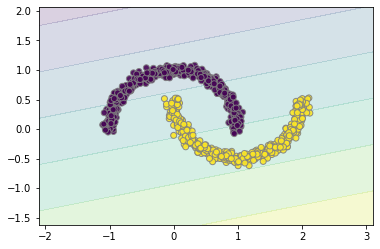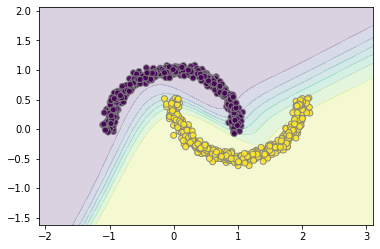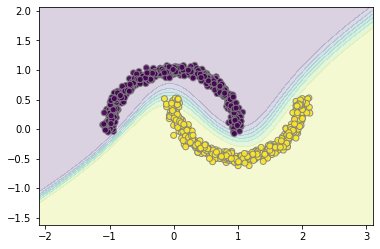General Applications of Neural Networks
Lab 1: Neural Network Linearity¶
Instructor: Wesley Beckner
Contact: wesleybeckner@gmail.com
In this lab we will compare the FFNNs to simple linear models
Data and Helper Functions¶
import plotly.express as px
from sklearn.datasets import make_blobs, make_moons
import pandas as pd
import numpy as np
import matplotlib.pyplot as plt
X, y = make_blobs(random_state=42, centers=2, cluster_std=3)
X, y = make_moons(random_state=42, noise=.05, n_samples=1000)
px.scatter(x=X[:,0],y=X[:,1],color=y.astype(str))
def plot_boundaries(X, clf, ax=False):
plot_step = 0.02
x_min, x_max = X[:, 0].min() - 1, X[:, 0].max() + 1
y_min, y_max = X[:, 1].min() - 1, X[:, 1].max() + 1
xx, yy = np.meshgrid(np.arange(x_min, x_max, plot_step),
np.arange(y_min, y_max, plot_step))
Z = clf.predict(np.c_[xx.ravel(), yy.ravel()])
Z = Z.reshape(xx.shape)
if ax:
cs = ax.contourf(xx, yy, Z, cmap='viridis', alpha=0.2)
ax.scatter(X[:,0], X[:,1], c=y, cmap='viridis', edgecolor='grey', alpha=0.9)
return ax
else:
cs = plt.contourf(xx, yy, Z, cmap='viridis', alpha=0.2)
plt.scatter(X[:,0], X[:,1], c=y, cmap='viridis', edgecolor='grey', alpha=0.9)
📈 L1 Q1: Build a Linear Model¶
Build and train a linear classification model using keras tf. Verify that the model is linear by either showing the weights or plotting the decision boundary (hint: you can use plot_boundaries above).
# Code Cell for L1 Q1
from tensorflow import keras
from tensorflow.keras import layers
model = keras.Sequential([
#### YOUR CODE HERE ###
])
model.compile(
optimizer='adam',
loss='binary_crossentropy',
metrics=['binary_accuracy'],
)
history = model.fit(X,y,
batch_size=100,
epochs=500,
verbose=0)
model.summary()
results = pd.DataFrame(history.history)
display(results.tail())
y_pred = model.predict(X) > 0.5
px.scatter(x=X[:,0],y=X[:,1], color=y_pred.astype(str))
Model: "sequential_14"
_________________________________________________________________
Layer (type) Output Shape Param #
=================================================================
dense_51 (Dense) (None, 2) 6
_________________________________________________________________
dense_52 (Dense) (None, 2) 6
_________________________________________________________________
dense_53 (Dense) (None, 2) 6
_________________________________________________________________
dense_54 (Dense) (None, 1) 3
=================================================================
Total params: 21
Trainable params: 21
Non-trainable params: 0
_________________________________________________________________
| loss | binary_accuracy | |
|---|---|---|
| 495 | 0.225831 | 0.888 |
| 496 | 0.225785 | 0.887 |
| 497 | 0.226102 | 0.888 |
| 498 | 0.225775 | 0.886 |
| 499 | 0.225990 | 0.888 |
plot_boundaries(X, model)

🌀 L1 Q2: Build a Non-Linear Model¶
Now add an activation function to your previous model. Does the model become non-linear?
# Code Cell for L1 Q2
model = keras.Sequential([
#### YOUR CODE HERE ###
])
model.compile(
optimizer='adam',
loss='binary_crossentropy',
metrics=['binary_accuracy'],
)
history = model.fit(X,y,
batch_size=100,
epochs=500,
verbose=0)
results = pd.DataFrame(history.history)
display(results.tail())
y_pred = model.predict(X) > 0.5
px.scatter(x=X[:,0],y=X[:,1],color=y_pred.astype(str))
| loss | binary_accuracy | |
|---|---|---|
| 495 | 0.093515 | 0.981 |
| 496 | 0.092895 | 0.981 |
| 497 | 0.091976 | 0.982 |
| 498 | 0.091197 | 0.982 |
| 499 | 0.090521 | 0.982 |
plot_boundaries(X, model)

✨ L1 Q3: Add Complexity¶
Continue to add complexity to your Q3 model until you get an accuracy above 99%
# Code Cell for L1 Q3
model = keras.Sequential([
#### YOUR CODE HERE ###
])
model.compile(
optimizer='adam',
loss='binary_crossentropy',
metrics=['binary_accuracy'],
)
history = model.fit(X,y,
batch_size=100,
epochs=100,
verbose=0)
results = pd.DataFrame(history.history)
display(results.tail())
y_pred = model.predict(X) > 0.5
px.scatter(x=X[:,0],y=X[:,1],color=y_pred.astype(str))
| loss | binary_accuracy | |
|---|---|---|
| 95 | 0.021280 | 1.0 |
| 96 | 0.019798 | 1.0 |
| 97 | 0.018461 | 1.0 |
| 98 | 0.017353 | 1.0 |
| 99 | 0.016389 | 1.0 |
plot_boundaries(X, model)
